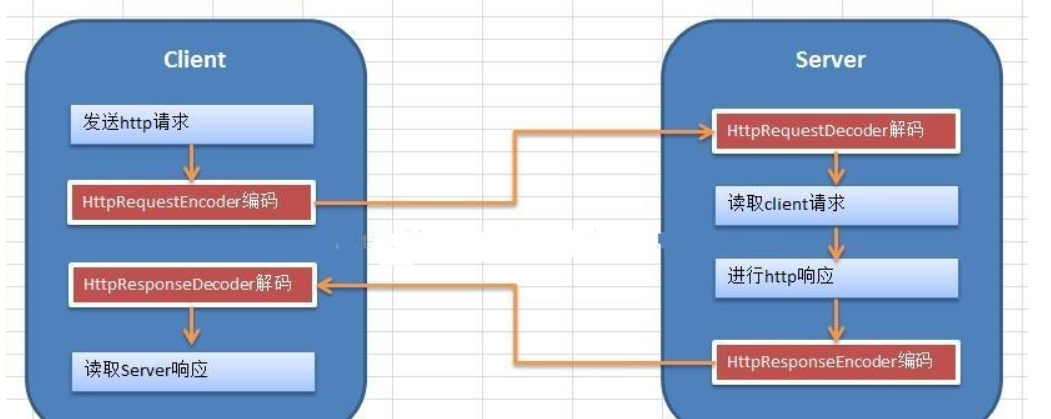基于Netty构建HTTP访问分为两类,使用浏览器访问的和使用Netty客户端访问。在介绍之前,先简单说一下如何使用Netty实现Http服务的。
Netty的Http服务的流程是:
1、Client向Server发送http请求。
2、Server端对http请求进行解析。
3、Server端向client发送http响应。
4、Client对http响应进行解析。
下图是网上复制别人的

直接上代码:
TestHttpServerHandler
package com.atguigu.netty.http; import io.netty.buffer.ByteBuf; import io.netty.buffer.Unpooled; import io.netty.channel.ChannelHandlerContext; import io.netty.channel.SimpleChannelInboundHandler; import io.netty.handler.codec.http.*; import io.netty.util.CharsetUtil; import java.net.URI; /* 说明 1. SimpleChannelInboundHandler 是 ChannelInboundHandlerAdapter 2. HttpObject 客户端和服务器端相互通讯的数据被封装成 HttpObject */ public class TestHttpServerHandler extends SimpleChannelInboundHandler<HttpObject> { //channelRead0 读取客户端数据 @Override protected void channelRead0(ChannelHandlerContext ctx, HttpObject msg) throws Exception { System.out.println("对应的channel=" + ctx.channel() + " pipeline=" + ctx .pipeline() + " 通过pipeline获取channel" + ctx.pipeline().channel()); System.out.println("当前ctx的handler=" + ctx.handler()); //判断 msg 是不是 httprequest请求 if(msg instanceof HttpRequest) { System.out.println("ctx 类型="+ctx.getClass()); System.out.println("pipeline hashcode" + ctx.pipeline().hashCode() + " TestHttpServerHandler hash=" + this.hashCode()); System.out.println("msg 类型=" + msg.getClass()); System.out.println("客户端地址" + ctx.channel().remoteAddress()); //获取到 HttpRequest httpRequest = (HttpRequest) msg; //获取uri, 过滤指定的资源 URI uri = new URI(httpRequest.uri()); if("/favicon.ico".equals(uri.getPath())) { System.out.println("请求了 favicon.ico, 不做响应"); return; } //回复信息给浏览器 [http协议] ByteBuf content = Unpooled.copiedBuffer("hello, 我是服务器", CharsetUtil.UTF_8); //构造一个http的相应,即 httpresponse FullHttpResponse response = new DefaultFullHttpResponse(HttpVersion.HTTP_1_1, HttpResponseStatus.OK, content); response.headers().set(HttpHeaderNames.CONTENT_TYPE, "text/plain;charset=UTF-8"); response.headers().set(HttpHeaderNames.CONTENT_LENGTH, content.readableBytes()); //将构建好 response返回 ctx.writeAndFlush(response); } } }
TestServerInitializer
TestServerInitializer import io.netty.channel.ChannelInitializer;import io.netty.channel.ChannelPipeline;import io.netty.channel.socket.SocketChannel;import io.netty.handler.codec.http.HttpServerCodec;public class TestServerInitializer extends ChannelInitializer<SocketChannel> { @Override protected void initChannel(SocketChannel ch) throws Exception { //向管道加入处理器 //得到管道 ChannelPipeline pipeline = ch.pipeline(); //加入一个netty 提供的httpServerCodec codec =>[coder - decoder] //HttpServerCodec 说明 //1. HttpServerCodec 是netty 提供的处理http的 编-解码器 pipeline.addLast("MyHttpServerCodec",new HttpServerCodec()); //2. 增加一个自定义的handler pipeline.addLast("MyTestHttpServerHandler", new TestHttpServerHandler()); System.out.println("ok~~~~"); }}
TestHttpServer
import io.netty.bootstrap.ServerBootstrap; import io.netty.channel.ChannelFuture; import io.netty.channel.EventLoopGroup; import io.netty.channel.nio.NioEventLoopGroup; import io.netty.channel.socket.nio.NioServerSocketChannel; public class TestServer { public static void main(String[] args) throws Exception { EventLoopGroup bossGroup = new NioEventLoopGroup(1); EventLoopGroup workerGroup = new NioEventLoopGroup(); try { ServerBootstrap serverBootstrap = new ServerBootstrap(); serverBootstrap.group(bossGroup, workerGroup).channel(NioServerSocketChannel.class).childHandler(new TestServerInitializer()); ChannelFuture channelFuture = serverBootstrap.bind(6668).sync(); channelFuture.channel().closeFuture().sync(); }finally { bossGroup.shutdownGracefully(); workerGroup.shutdownGracefully(); } } }
注意:
1.如果6668端口浏览器无法访问:参照 《window的对外开放端口》
2.浏览器乱码请设置浏览器的charset,消息头中
3.访问发现每次都有两次请求: 另外一个请求时浏览器的图标请求:
/favicon.ico, 可以F12看,每次都会有



